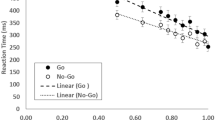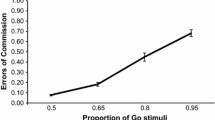Abstract
In the current investigation, we modified the high Go, low No-Go Sustained Attention to Response Task (SART) by replacing the single response on Go trials with a dual response to increase response uncertainty. In three experiments, a total of 80 participants completed either the original SART with no response uncertainty regarding the Go stimuli, or versions of the dual response SART in which response probabilities for the two possible responses to the Go stimuli varied from 0.9–0.1, 0.7–0.3, to 0.5–0.5. This resulted in a scale of increasing response uncertainty based on information theory to the Go stimuli. The probability of No-Go withhold stimuli was kept.11 in all experiments. Using the Signal Detection Theory perspective proposed by Bedi et al. (Psychological Research: 1–10, 2022), we predicted that increasing response uncertainty would result in a conservative response bias shift, noted by decreased errors of commission and slower response times to both Go and No-Go stimuli. These predictions were verified. The errors of commission in the SART may not be a measures of conscious awareness per se, but instead indicative of the level of participant trigger happiness—the willingness to respond quickly.





Similar content being viewed by others
Data availability
The dataset for the current study is not publicly available due the fact that they constitute an excerpt of research in progress but are available from the corresponding author on reasonable request.
References
Aitken, J. A., Pagan, O., Wong, C. M., Bayley, B., Helton, W. S., & Kaplan, S. A. (2023). Task-related and task-unrelated thoughts in runners and equestrians: Measurement issues in evaluations of thought content. Applied Ergonomics, 110, 104011.
Baddeley, A. D., & Colquhoun, W. P. (1969). Signal probability and vigilance: A reappraisal of the ‘signal-rate’effect. British Journal of Psychology, 60(2), 169–178.
Baldwin, C. L., & Lewis, B. A. (2017). Positive valence music restores executive control over sustained attention. PLoS ONE, 12(11), e0186231.
Bedi, A., Russell, P. N., & Helton, W. S. (2023). Go-stimuli probability influences response bias in the sustained attention to response task: A signal detection theory perspective. Psychological Research, 87(2), 509–518.
Bellgrove, M. A., Hawi, Z., Kirley, A., Gill, M., & Robertson, I. H. (2005). Dissecting the attention deficit hyperactivity disorder (ADHD) phenotype: Sustained attention, response variability and spatial attentional asymmetries in relation to dopamine transporter (DAT1) genotype. Neuropsychologia, 43(13), 1847–1857.
Blakely, M. J., Kemp, S., & Helton, W. S. (2016). Volitional running and tone counting: The impact of cognitive load on running over natural terrain. IIE Transactions on Occupational Ergonomics and Human Factors, 4(2–3), 104–114.
Carter, L., Russell, P. N., & Helton, W. S. (2013). Target predictability, sustained attention, and response inhibition. Brain and Cognition, 82(1), 35–42.
Cheyne, J. A., Solman, G. J., Carriere, J. S., & Smilek, D. (2009). Anatomy of an error: A bidirectional state model of task engagement/disengagement and attention-related errors. Cognition, 111(1), 98–113.
Christoff, K., Gordon, A. M., Smallwood, J., Smith, R., & Schooler, J. W. (2009). Experience sampling during fMRI reveals default network and executive system contributions to mind wandering. Proceedings of the National Academy of Sciences, 106(21), 8719–8724.
Clark, A. (2013). Whatever next? Predictive brains, situated agents, and the future of cognitive science. Behavioral and Brain Sciences, 36(3), 181–204.
Dang, J. S., Figueroa, I. J., & Helton, W. S. (2018). You are measuring the decision to be fast, not inattention: The sustained attention to response task does not measure sustained attention. Experimental Brain Research, 236(8), 2255–2262.
Draheim, C., Tsukahara, J. S., Martin, J. D., Mashburn, C. A., & Engle, R. W. (2021). A toolbox approach to improving the measurement of attention control. Journal of Experimental Psychology: General, 150(2), 242–275.
Fitts, P. M., & Posner, M. I. (1967). Human performance. Brooks/Cole.
Green, D. M., & Swets, J. A. (1966). Signal detection theory and psychophysics. Wiley.
Hautus, M. J. (1995). Corrections for extreme proportions and their biasing effects on estimated values of d′. Behavior Research Methods, Instruments, & Computers, 27(1), 46–51.
Hawkins, G. E., Mittner, M., Forstmann, B. U., & Heathcote, A. (2019). Modeling distracted performance. Cognitive Psychology, 112, 48–80.
Head, J., & Helton, W. S. (2018). The troubling science of neurophenomenology. Experimental Brain Research, 236(9), 2463–2467.
Head, J., Tenan, M. S., Tweedell, A. J., Wilson, K. M., & Helton, W. S. (2020). Response complexity reduces errors on a response inhibition task. Human Factors, 62(5), 787–799.
Helton, W. S. (2009). Impulsive responding and the sustained attention to response task. Journal of Clinical and Experimental Neuropsychology, 31(1), 39–47.
Helton, W. S., Dember, W. N., Warm, J. S., & Matthews, G. (1999). Optimism, pessimism, and false failure feedback: Effects on vigilance performance. Current Psychology, 18(4), 311–325.
Helton, W. S., & Head, J. (2012). Earthquakes on the mind: Implications of disasters for human performance. Human Factors, 54(2), 189–194.
Helton, W. S., Jackson, K. M., Näswall, K., & Humphrey, B. (2022). The national aviation and space agency task load index (NASA-TLX): does it need updating? Proceedings of the Human Factors and Ergonomics Society, 66, 1245–1249.
Helton, W. S., Weil, L., Middlemiss, A., & Sawers, A. (2010). Global interference and spatial uncertainty in the sustained attention to response task (SART). Consciousness and Cognition, 19(1), 77–85.
Ho, M. C., Li, R. H., & Tang, T. C. (2015). Betel nut chewing effects on sustained attention and inhibitory control after sleep deprivation. Australian Journal of Psychology, 67(4), 222–230.
Jackson, J. D., & Balota, D. A. (2012). Mind-wandering in younger and older adults: Converging evidence from the sustained attention to response task and reading for comprehension. Psychology and Aging, 27(1), 106–119.
Johnson, A. J., Muneem, M., & Miles, C. (2013). Chewing gum benefits sustained attention in the absence of task degradation. Nutritional Neuroscience, 16(4), 153–159.
Kane, M. J., Smeekens, B. A., Meier, M. E., Welhaf, M. S., & Phillips, N. E. (2021). Testing the construct validity of competing measurement approaches to probed mind-wandering reports. Behavior Research Methods, 53(6), 2372–2411.
Lo, J. C., Ong, J. L., Leong, R. L., Gooley, J. J., & Chee, M. W. (2016). Cognitive performance, sleepiness, and mood in partially sleep deprived adolescents: The need for sleep study. Sleep, 39(3), 687–698.
Lynn, S. K., & Barrett, L. F. (2014). “Utilizing” signal detection theory. Psychological Science, 25(9), 1663–1673.
Mackworth, N. H. (1948). The breakdown of vigilance during prolonged visual search. Quarterly Journal of Experimental Psychology, 1(1), 6–21.
Manly, T., Robertson, I. H., Galloway, M., & Hawkins, K. (1999). The absent mind: Further investigations of sustained attention to response. Neuropsychologia, 37(6), 661–670.
McAvinue, L., O’Keeffe, F., McMackin, D., & Robertson, I. H. (2005). Impaired sustained attention and error awareness in traumatic brain injury: Implications for insight. Neuropsychological Rehabilitation, 15(5), 569–587.
McVay, J. C., & Kane, M. J. (2009). Conducting the train of thought: Working memory capacity, goal neglect, and mind wandering in an executive-control task. Journal of Experimental Psychology: Learning, Memory, and Cognition, 35(1), 196–204.
McVay, J. C., & Kane, M. J. (2012). Drifting from slow to “d’oh!”: Working memory capacity and mind wandering predict extreme reaction times and executive control errors. Journal of Experimental Psychology: Learning, Memory, and Cognition, 38(3), 525–549.
Miller, J. (1998). Effects of stimulus-response probability on choice reaction time: Evidence from the lateralized readiness potential. Journal of Experimental Psychology: Human Perception and Performance, 24(5), 1521–1534.
Miller, J., & Pachella, R. G. (1973). Locus of the stimulus probability effect. Journal of Experimental Psychology, 101(2), 227–231.
Mrazek, M. D., Smallwood, J., & Schooler, J. W. (2012). Mindfulness and mind-wandering: Finding convergence through opposing constructs. Emotion, 12(3), 442.
Mueller, S. T., Alam, L., Funke, G. J., Linja, A., Ibne Mamun, T., & Smith, S. L. (2020). Examining methods for combining speed and accuracy in a Go/No-Go vigilance task. Proceedings of the Human Factors and Ergonomics Society, 64, 1202–1206.
Nuechterlein, K. H., Parasuraman, R., & Jiang, Q. (1983). Visual sustained attention: Image degradation produces rapid sensitivity decrement over time. Science, 220(4594), 327–329.
Parasuraman, R., & Davies, D. R. (1976). Decision theory analysis of response latencies in vigilance. Journal of Experimental Psychology: Human Perception and Performance, 2(4), 578–590.
Peebles, D., & Bothell, D. (2004). Modelling performance in the sustained attention to response task. In ICCM (pp. 231–236).
Rey-Mermet, A., Gade, M., Souza, A. S., Von Bastian, C. C., & Oberauer, K. (2019). Is executive control related to working memory capacity and fluid intelligence? Journal of Experimental Psychology: General, 148(8), 1335–1372.
Robertson, I. H., Manly, T., Andrade, J., Baddeley, B. T., & Yiend, J. (1997). Oops!’: Performance correlates of everyday attentional failures in traumatic brain injured and normal subjects. Neuropsychologia, 35(6), 747–758.
Seli, P. (2016). The attention-lapse and motor decoupling accounts of SART performance are not mutually exclusive. Consciousness and Cognition, 41, 189–198.
Stanislaw, H., & Todorov, N. (1999). Calculation of signal detection theory measures. Behavior Research Methods, Instruments, & Computers, 31(1), 137–149.
Temple, J. G., Warm, J. S., Dember, W. N., Jones, K. S., LaGrange, C. M., & Matthews, G. (2000). The effects of signal salience and caffeine on performance, workload, and stress in an abbreviated vigilance task. Human Factors, 42(2), 183–194.
Unsworth, N., Robison, M. K., & Miller, A. L. (2021). Individual differences in lapses of attention: A latent variable analysis. Journal of Experimental Psychology: General, 150(7), 1303–1331.
Verbruggen, F., & Logan, G. D. (2008). Response inhibition in the stop-signal paradigm. Trends in Cognitive Sciences, 12(11), 418–424.
Whyte, J., Grieb-Neff, P., Gantz, C., & Polansky, M. (2006). Measuring sustained attention after traumatic brain injury: Differences in key findings from the sustained attention to response task (SART). Neuropsychologia, 44(10), 2007–2014.
Wilson, K. M., Finkbeiner, K. M., De Joux, N. R., Russell, P. N., & Helton, W. S. (2016). Go-stimuli proportion influences response strategy in a sustained attention to response task. Experimental Brain Research, 234(10), 2989–2998.
Wyart, V., Nobre, A. C., & Summerfield, C. (2012). Dissociable prior influences of signal probability and relevance on visual contrast sensitivity. Proceedings of the National Academy of Sciences, 109(9), 3593–3598.
Funding
No external funding was utilized for this study.
Author information
Authors and Affiliations
Contributions
AB, PR, and WH wrote the main manuscript text, W.H. prepared the tables and figures. All authors reviewed the manuscript.
Corresponding author
Ethics declarations
Conflict of interest
All authors declare that they have no conflicts of interest.
Ethical approval
All procedures performed in this study involving human participants were in accordance with the ethical standards of the institutional research committee of the University of Canterbury and with the 1964 Helsinki declaration and its later amendments.
Informed consent
Informed consent was obtained from all individual participants included in the study.
Additional information
Publisher's Note
Springer Nature remains neutral with regard to jurisdictional claims in published maps and institutional affiliations.
Rights and permissions
Springer Nature or its licensor (e.g. a society or other partner) holds exclusive rights to this article under a publishing agreement with the author(s) or other rightsholder(s); author self-archiving of the accepted manuscript version of this article is solely governed by the terms of such publishing agreement and applicable law.
About this article
Cite this article
Bedi, A., Russell, P.N. & Helton, W.S. Response uncertainty influences response bias in the sustained attention to response task: a signal detection theory perspective. Psychological Research 88, 81–90 (2024). https://doi.org/10.1007/s00426-023-01847-3
Received:
Accepted:
Published:
Issue Date:
DOI: https://doi.org/10.1007/s00426-023-01847-3




